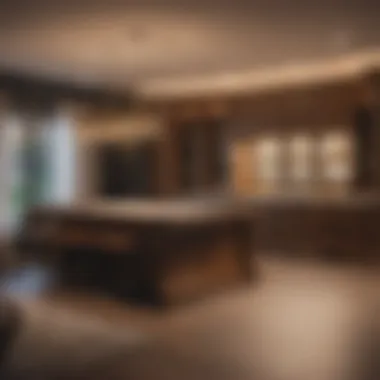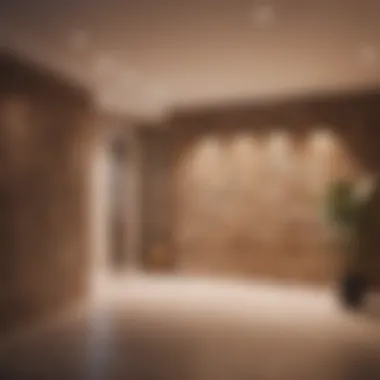Materials:
- Drywall sheets: 20 pieces of 4x8 ft each
- Studs: 2x4 wooden studs (UL-rated) in quantities of 25 pieces
- Insulation: R-15 batt insulation for wall cavities, 15 rolls
- Flooring: Laminate or vinyl flooring, covering an area of 500 sq ft
- Paint: Semi-gloss or satin finish interior paint, 5 gallons
- Baseboard trim: 4-inch MDF baseboard in lengths totaling 100 linear feet
- Ceiling tiles: Acoustic ceiling tiles, 2x2 ft dimensions
- Lighting fixtures: Recessed LED lights or track lighting system
- Electrical wiring: 12/2 and 14/2 Romex wiring for outlets and switches
- HVAC materials: Duct insulation and vents for climate control
DIY Steps:
- Planning: Measure the basement space and create a layout plan for optimal utilization.
- Insulation: Install R-15 batt insulation between studs for energy efficiency.
- Drywall Installation: Secure drywall sheets to studs using drywall screws and joint compound for finishing.
- Flooring Installation: Lay down underlayment and install laminate or vinyl flooring according to manufacturer's guidelines.
- Painting: Prime walls and apply 2 coats of interior paint for a smooth finish.
- Trim Work: Cut and install baseboard trim along the walls for a polished look.
- Ceiling Improvement: Replace or install acoustic ceiling tiles for enhanced aesthetics.
- Lighting Setup: Wire and mount recessed LED lights or a track lighting system for adequate illumination.
- Electrical Wiring: Run Romex wiring for outlets and switches, ensuring compliance with electrical codes.
- HVAC Integration: Insulate ductwork and install vents for proper air circulation.
Technical Aspects:
- Tools: Hammer, screwdriver, tape measure, drywall saw, paintbrushes, flooring installation kit
- Timing: Allow 2-3 weeks for the entire basement finishing process
- Techniques: Mudding and taping drywall joints, cutting precision for trim work, proper electrical wiring connections
DIY Project Process:
- Step 1 - Insulation: Ensure proper alignment and snug fit of insulation between studs to prevent heat loss.
- Step 2 - Drywall Installation: Secure drywall with evenly spaced screws and apply joint compound for seamless walls.
- Step 3 - Flooring: Start from one corner and work across the room, locking each piece securely in place.
- Step 4 - Painting: Begin with primer and allow drying time between coats for a professional finish.
- Step 5 - Trim Work: Measure and cut baseboard trim with precision angles for a neat appearance.
- Step 6 - Lighting Fixture Installation: Position lights evenly for balanced illumination throughout the basement.
- Step 7 - Electrical Wiring: Follow electrical diagrams for efficient placement of outlets and switches.
- Step 8 - HVAC Integration: Seal duct joints and position vents strategically for optimal airflow.
Troubleshooting Tips:


- If drywall seams show through, apply additional coats of joint compound.
- For flooring gaps, use a tapping block and mallet to ensure tight connections.
- Inadequate lighting can be addressed by adding supplemental lighting fixtures.
- Electrical issues may require consulting a licensed electrician for safety and compliance.
- HVAC concerns, such as uneven heating or cooling, may need expert evaluation for proper functionality.
Introduction


When considering finishing a basement, it is crucial to recognize the multifaceted aspects that play a crucial role in determining the overall cost. From the quality of materials and labor to the impact of permits, design choices, and even your location, each factor carries its weight in contributing to the final budget. This introduction sets the stage for a detailed exploration of how these components intertwine to shape the financial framework of your basement finishing project.
As we embark on this insightful journey into the world of basement finishing costs, be prepared to unravel the complexities, implications, and strategies that will guide you from the initial planning stages to the ultimate enjoyment of your beautifully renovated basement retreat.
Factors Influencing Basement Finishing Costs


In the realm of home renovations, finishing a basement stands out as a significant project that involves multiple factors influencing costs. Among these, materials, labor, permits and regulations, design choices, and even the location of the property all play pivotal roles in determining the overall expense. Understanding each of these elements is crucial for anyone embarking on the journey of transforming a basement into a livable space.
Materials
Quality of Materials
When considering the quality of materials for finishing a basement, it's imperative to prioritize durability and suitability for the intended use. Opting for high-quality materials may entail a higher upfront cost but can translate into long-term savings by reducing the need for repairs or replacements. Materials with excellent insulation properties and resistance to moisture are particularly vital in basements to ensure comfort and prevent issues like mold growth. Selecting quality materials sets the foundation for a well-constructed and enduring finished basement.
Types of Finishes
The types of finishes chosen for a basement can greatly impact both the aesthetics and functionality of the space. From flooring options to wall treatments, each choice contributes to the overall ambiance and usability of the area. Selecting finishes that align with the desired style while also being practical and resilient is key. For example, waterproof flooring can be essential in a basement to safeguard against potential water damage. Considering finishes that fuse style and substance is essential in creating a cohesive and enriching environment.
Insulation and Waterproofing
Insulation and waterproofing are crucial aspects of finishing a basement that are often underestimated. Proper insulation not only helps regulate temperature within the space but also enhances energy efficiency, leading to long-term cost savings on heating and cooling. Waterproofing, on the other hand, is essential for protecting the basement against water intrusion, which can lead to structural damage and environmental hazards. Investing in quality insulation and effective waterproofing measures is a wise choice that can enhance the comfort, durability, and value of a finished basement.
Labor
Cost of Hiring Professionals
Housewives and homeowners carefully evaluate the cost of hiring professionals when considering a basement finishing project, weighing the benefits of expertise and efficiency against the associated expenses. Professional contractors bring a wealth of experience and skill to the table, ensuring that the project is completed with high quality and in a timely manner. While their services come at a cost, the peace of mind and superior results they offer can justify the investment for many individuals looking to transform their basement into a functional and inviting space.
DIY vs. Professional Installation
The decision between a do-it-yourself (DIY) approach and hiring professionals for basement installation is a critical factor impacting the overall cost. DIY projects can potentially save on labor expenses but require significant time and effort, as well as a certain level of skill and knowledge. On the other hand, professional installation guarantees craftsmanship and adherence to building codes, albeit at a higher cost. Housewives and homeowners must weigh their capabilities, availability, and budget constraints to determine the most suitable path for their basement finishing endeavor.
I hope you found this information helpful in understanding the intricate details of factors influencing basement finishing costs. Stay tuned for more insights into permits and regulations, design choices, and the impact of location on budgeting for basement renovations.
Cost Breakdown
Cost of Materials
Materials play a significant role in determining the overall cost of finishing a basement. The quality of materials chosen, such as flooring, wall finishes, and fixtures, can greatly impact the budget. Opting for high-end finishes will escalate costs, while choosing more budget-friendly options can help save money without compromising on quality. It is essential to research different material prices, compare options, and consider durability to ensure a cost-effective yet long-lasting investment.
Labor Costs
Labor costs are another substantial factor to consider when budgeting for finishing a basement. Hiring professionals for tasks like framing, electrical work, and plumbing can quickly add up. Understanding the average hourly rates for contractors in your area and comparing quotes from multiple professionals can help in negotiating better deals. Homeowners also have the option of DIY projects to save on labor costs but should evaluate their skill level and the complexity of tasks before taking this route.
Permit Expenses
Permits are often required for basement finishing projects, adding an additional layer of expense. The cost of permits can vary depending on the location and the scope of work being done. It is essential to research permit requirements in your area, factor in the associated fees, and include them in the overall budget to avoid any legal or financial implications post-construction.
Design Charges
Design charges encompass the fees associated with hiring a professional designer or architect to create blueprints and layout plans for the basement renovation. These charges can vary based on the complexity of the design and the level of customization desired. Homeowners should carefully consider whether they need professional design services or can opt for pre-existing design templates to control costs while achieving their desired aesthetic.
Ways to Control and Reduce Costs
When it comes to finishing a basement, controlling and reducing costs is a crucial aspect that can significantly impact the overall budget of the project. In this section, we will delve into various strategies that can help homeowners save money while still achieving their desired renovation goals.
Do-It-Yourself (DIY) Approach
Benefits of DIY
Embracing a do-it-yourself (DIY) approach when finishing a basement can offer numerous advantages. One key benefit is cost savings, as homeowners can eliminate labor costs by taking on tasks themselves. Additionally, DIY allows for greater customization and control over the project, ensuring that the final result meets personal preferences and requirements. This hands-on approach can also lead to a sense of pride and accomplishment, as homeowners actively contribute to transforming their living space.
Considerations Before DIY
Before opting for a DIY approach, certain considerations need to be taken into account. Homeowners should assess their skills and knowledge to determine if they are capable of executing the renovation tasks effectively. Time constraints and the availability of tools and equipment must also be considered to ensure a smooth workflow. Moreover, analyzing the complexity of the project and potential risks involved is essential to prevent costly mistakes or delays. While DIY can bring cost savings and a sense of fulfillment, it is vital to weigh the advantages against the challenges to make an informed decision that suits the individual's capabilities and goals.
Budget-Friendly Materials
Alternative Options
Exploring alternative materials can be a practical way to reduce costs when finishing a basement. Opting for cost-effective alternatives that mimic the look of luxurious materials can help homeowners achieve the desired aesthetic without overspending. By researching and comparing various options, individuals can find budget-friendly materials that align with their design vision and financial constraints. Alternative options provide flexibility in customizing the basement while being mindful of budgetary concerns, offering a balanced approach to creating a stylish and affordable living space.
Cost-Effective Alternatives
Incorporating cost-effective alternatives into the renovation project can significantly impact the overall expenses. Seeking out discounted or clearance materials, utilizing recycled or repurposed items, or considering wholesale purchases are viable strategies to save money without compromising quality. Cost-effective alternatives enable homeowners to stretch their budget further and allocate resources wisely without sacrificing the aesthetic or functionality of the finished basement. By prioritizing value and affordability in material choices, individuals can achieve a cost-conscious yet visually appealing result that enhances the overall living environment.
Efficient Design Choices
(To be continued in the next commissioned section)
Conclusion
This conclusion section allows readers to reflect on the intricate details explored throughout the article, highlighting the importance of meticulous planning and consideration when embarking on a basement finishing project. It encapsulates the essence of the cost analysis, emphasizing the need for a balanced approach between quality and affordability. Moreover, the conclusion underlines the significance of taking into account various cost-saving strategies and factors that can help optimize the budget without compromising the desired outcome.





